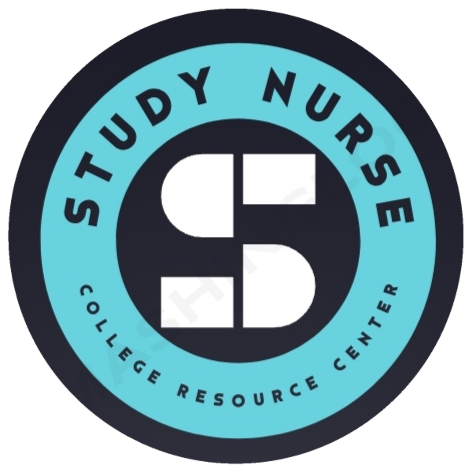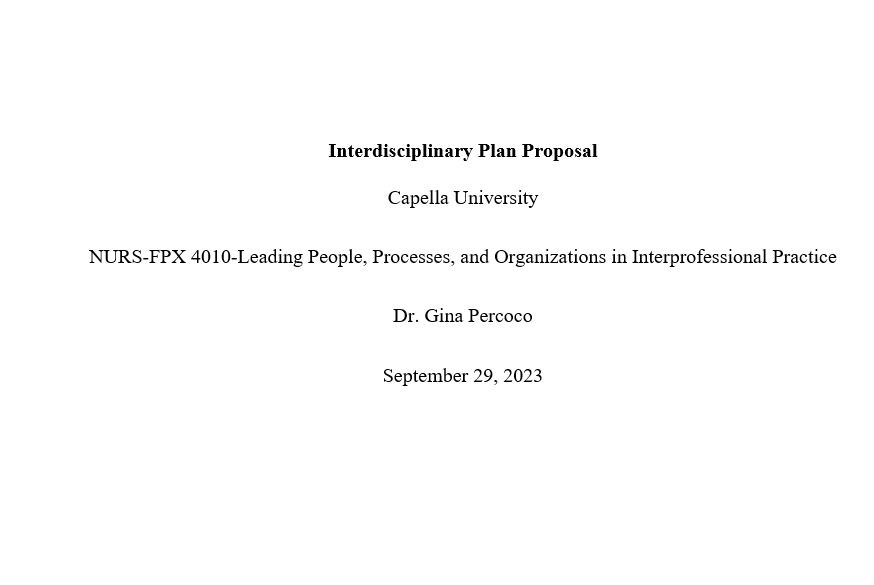NURS-FPX4010_Sa_Assessment 3-1 solution.docx
Interdisciplinary Plan Proposal
Capella University
NURS-FPX 4010-Leading People, Processes, and Organizations in Interprofessional Practice
Dr. Gina Percoco
September 29, 2023
Interdisciplinary Plan Proposal
Hospitals strive to improve quality and safety of patient care. The efforts involve establishing strategic goals characterized by commitment to encouraging collective participation in creating a shared vision. Members of a diverse care team share expertise, knowledge, and experiences that foster collective responsibility towards optimizing care outcomes.
Nurses, pharmacists, physicians, and other members of the care team identify gaps and improvement opportunities available to sustain safe medication administration.
Objectives and Predictions
- To address the various risk factors associated with wrong drug administrative in palliative care. The prediction is that the audience will identify several risks, including technical, administrative, and human-related ones that undermine collective commitment to mitigating medication errors (Manias, 2018). Awareness of the risks reinforce shared dedication to strengthening vigilance during medication preparation and administration.
- To highlight the relevance of shared interdisciplinary governance in reducing medication administration errors. The educational sessions will reinforce the need for attitudes, behaviors, and practices that encourage everyone to share ideas, skills, and experiences on interventions for medication errors. The prediction is that employees will embrace team-based functions that make them responsive to patients’ expectations.
- Inform the audience about the value of effective use of barcode medication administration. The prediction is that the care team will understand the implications of technological interventions on the quality and safety of patient care (Khalil & Lee, 2018). Specifically, the team will acknowledges their contributions towards helping the organization respond to evolutions in the healthcare sector.
Change Theory and Leadership Practice
Leadership skills in medication safety initiatives determine the responses from different healthcare professionals towards quality and safety of patient care. Contemporary practices require leaders to integrate team-based functions such that everyone has a responsibility towards assessing progress in strengthening vigilance across the facility (Gupta et al., 2017).
The right leaders empower the workforce to commit to a shared purpose, build their competence consistently, and develop credibility across the care continuum. The highly functioning leaders also invest in developing individuals and teams’ critical thinking through tailored development programs and distributed governance (Hussain et al., 2018).
Further, leaders should encourage healthcare professionals to make decisions with the patient in mind. The process allows everyone to seek new and better ways to achieve outcomes more efficiently and effectively. Thus, leaders should create a cohesive team guided by performance metrics that help foster a culture of medication safety.
The PDSA cycle is appropriate for making everyone responsive to reforms on medication safety. The systematic framework helps leaders and the care team initiate and implement transformational changes by visualizing shifts in safety culture.
The PDSA cycle supports effective planning, leadership, and collective support towards addressing risks and sustainable solutions for medication errors. In the end, everyone participates in the various phases of change to identify evidence-based practices for eliminating errors across the care continuum.
Collaboration Strategy
The care team includes nurses, pharmacists, physicians, nurse manager, and a nurse educator. The frontline roles and close contact with patients make the members familiar with events in the clinical environment. The team also understands the need for viable and sustainable measures for preventing medication errors.
Team-based functions encourage them to embrace values, attitudes, and behaviors that make them responsive to strategic priorities on improving quality and safety of patient care (Manias, 2018). Open and honest conversations will build confidence and create an environment where everyone shares ideas, skills, and experiences on overcoming medication errors.
Vanderbilt University Medical Center is an example of a facility that responded to a medication error by implementing collaborative solutions (Kelman & Tamburin, 2019). The facility faced a lawsuit due to a fatal drug-swap that triggered administration of a wrong drug. Specifically, a nurse administered the paralyzing drug vecuronium instead of versed, leading to death of the patient. The error reinforced the need for training on coordinated practices to prevent negligent acts
Resources
The educational session would require health leaders to allocate adequate resources to enhance viability and effectiveness of the plan in improving quality and safety of patient care. In this case, the educator and audience need resources such as medication safety handouts, a case study on risks, implications, and solutions, and pocket guides on safe medication administration.
The nurse educator hired for the session will share insights on evidence-based reforms focused on collaborative initiatives necessary to reduce medication errors. The Vanderbilt medication error case highlights the consequences of injecting the wrong drug. The scenario highlighted the need for training to make the care team aware of the implications of overlooking warnings, distractions, and double verification on patient safety.
Table 1
Resources
| Resource | Description | Cost ($) |
| Safety checklists | The resource outlines risks, the most sensitive areas, and interventions necessary to prevent errors. | 50 |
| Pocket handouts | Members have a convenient and flexible resource that allows them to understand medication risks in palliative care and appropriate responses. | 50 |
| Nurse Educator | Hired as a consultant to guide the team through challenges in the clinical environment and collaborative approaches necessary to reduce medication errors. | 1,500 |
| A case study | The Vanderbilt medication error will make the team aware of multiple risks that expose patients to adverse drug reactions. | 100 |
| TOTAL | 1,700 |
References
Crowfoot, D., & Prasad, V. (2017). Using the Plan-Do-Study-Act (PSDA) cycle to make change in general practice. InnovAIT, 10(7), 425-430. https://journals.sagepub.com/doi/abs/10.1177/1755738017704472
Gupta, D., Boland, R., & Aron, D. (2017). The physician’s experience of changing clinical practice: A struggle to unlearn. Implementation Science, 12(28), 1-10. https://implementationscience.biomedcentral.com/articles/10.1186/s13012-017-0555-2
Hussain, S. T., Lei, S., Akram, T., Haider, M. J., Hussain, S. H., & Ali, M. (2018). Kurt Lewin’s change model: A critical review of the role of leadership and employee involvement in organizational change. Journal of Innovation and Knowledge, 3(3), 123-127. https://www.sciencedirect.com/science/article/pii/S2444569X16300087
Kelman, B., & Tamburin, A. (2019, March 28). RaDonda Vaught made at least 10 mistakes in fatal Vanderbilt medication error, prosecutors say. The Tennessean. https://www.tennessean.com/story/news/health/2019/03/27/radonda-vaught-vanderbilt-nurse-homicide-trial-vecuronium-versed/3216750002/
Khalil, H & Lee, S. (2018). The implementation of a successful medication safety program in a primary care. Journal of Evaluation in Clinical Practice, 24(5), 1-5. https://onlinelibrary.wiley.com/doi/abs/10.1111/jep.12870
Manias, E. (2018). Effects of interdisciplinary collaboration in hospitals on medication errors: An integrative review. Expert Opinion on Drug Safety, 17(3), 259-275. https://pubmed.ncbi.nlm.nih.gov/29303376/



